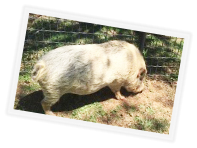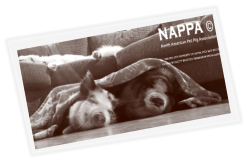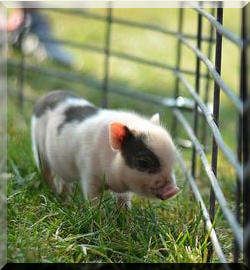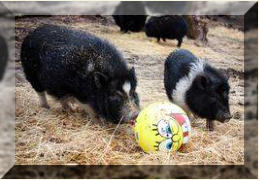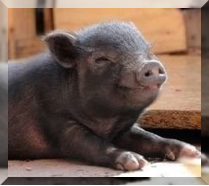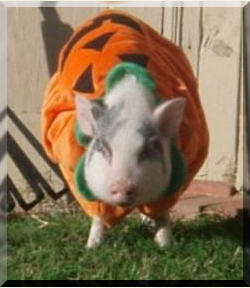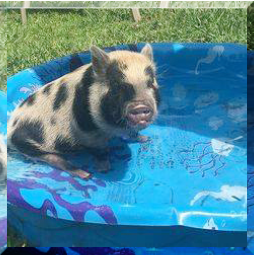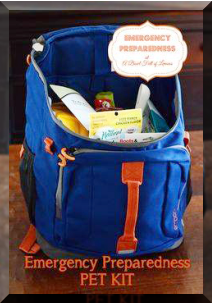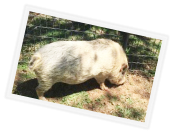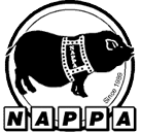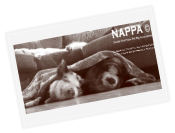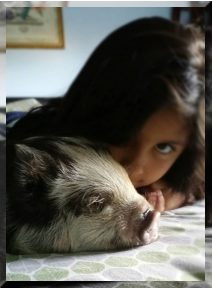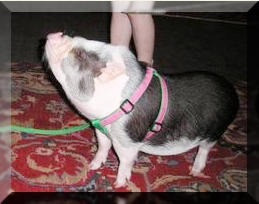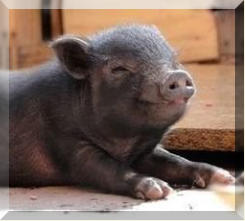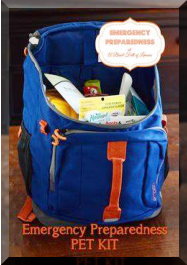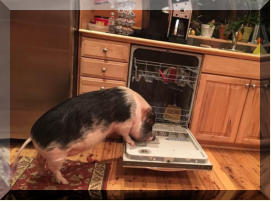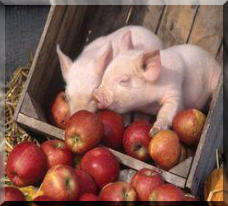BACK TO TOP
FOR MORE INFORMATION, E-MAIL: nappapignews@yahoo.com
2022-2025 Designed by: WimberlysWebWorks.com




Learn, Play, Bond!
Care shouldn’t be complicated, it should inform you! Get expert tips on pig parenting, training, common pig problems, and pig-friendly activities. The North American Pet Pig Association (NAPPA) team is here to answer all your porcine FAQ’s! Our expert pig info covers every pig-worthy topics for new pig parents, like behavior tips, piggy pointers, and more with info from Dr. John Carr, BVS PhD ECPHM MRCVS, who has taught medicine to veterinarians and farmers throughout the world through microbiology positions at several universities including North Carolina and Iowa, along with NAPPA, whose mission is to preserve pet pigs as a pet throughout the United States and Patty Hill, the president of Northwest Miniature Pig Association (NWMPA), who is an expert with behavior issues and training for pet pigs.Articles:
• Keeping Your Pet Pig Safe in the Summer Heat • Halloween Items Your Pet Pig Should Avoid • 5 Steps to a Pig-Safe Home • Are You Ready for a Pet Pig? • How Much Does it Cost to Own a Pet Pig? • How to Know if You’re Ready to Adopt a Pet Pig? • Tips for Solving Common Pet Pig ProblemsKeeping Your Pet Pig Safe in the Summer Heat
Ah, those lazy days of summer- or not? Even though the weather has become a lot warmer in the afternoon, don’t allow your pig to become a couch potato. They still need exercise, although it’s essential to take extra precautions to keep them healthy and safe no matter how high the mercury rises, but don’t overdo it. During the summer months, it’s especially important to take things slowly with your pet pig to prevent them from overheating. Keep exercise sessions short and sweet- a shorter walk outdoors followed by a break and then a play session indoors may be just the right mix. And on especially hot days, try exercise indoors as much as possible to keep your pig cool and comfortable. Avoid the hottest part of the day: In general, the sun is at its peak between 10 a.m. and 2 p.m., so it’s best to exercise your pig in the early morning or evening, when temperatures are cooler. Provide lots of water: Did you know that your pig’s body comprises approximately 70 percent water? Water is an essential nutrient that keeps their cells functioning properly; without it, their body will shut down. While exercising, a pig sweats primarily through area about their nose, so it’s crucial that they have access to cool, fresh water at all times to replace what they’re expending. If they play outdoors, place a water bowl in a shady area to ensure easy access. Apply sunscreen: It may seem odd, but pet pigs can become sunburned, just as humans do! Light-colored and black colored are especially susceptible. For the best protection, apply adult –specific sunscreen to your pig’s ears, and anywhere you see pink skin. Supervise all activities: No matter which activities you and your pig enjoy, supervise them at all times. For example, swimming can be a fun summertime sport, and many pigs enjoy the water immensely, but the swimming pool can be a dangerous place. Make sure the pool is fenced to prevent your pig from accidentally falling in, and install a ramp to make getting in and out of the water a breeze. Observe your pet pig’s condition: Whenever you and your pet pig are outdoors in warm weather, watch for signs of overexertion or heatstroke. A pig with a heatstroke may display symptoms such as rapid open –mouth breathing, a pounding heartbeat, and high body temperature. Call the vet immediately if your pig experiencing this emergency medical condition. Your best bet is to prevent the problem in the first place by limiting strenuous outdoor exercise on warm days and never leaving your pet pig in poorly ventilated areas. BACK TO ARTICLE LISTHalloween Items Your Pet Pig Should Avoid
When the calendar page flips to October, count on a chill in the air, leaves changing from red to amber, and hot soups and football games. The tenth month of the year also signals the end of the harvest season, the beginning of the holiday festivities, and, on October 31, the magical night of Halloween. That’s when children dress up as ghosts and princesses, go to door to door asking for candy, and call out, “Trick or Treat!” The kids are happy, but your pet pig? Not so much. When they see you give the little ones a sweet treat that they pop in their mouths or drop into their pumpkins, your pig will naturally want in on the goodies. They love food! and when they look at those big piggy-pig eyes, you will think they are hungry. If this tempts you to unwrap a piece of candy and give it to them, resist the urge! Chances are, they won’t be hungry, especially if you feed them dinner before the superheroes and cheerleaders come knocking. They will just want to eat what you and the kids are eating, but don’t give in! Candy is Not Dandy for Pet Pigs! Candy of all forms is unhealthy for pigs. Also forget giving your pet pig candy made with xylitol. This non- caloric sweetener, used in sugar-free gum, candy, and baked goods, is off-limits. While xylitol doesn’t affect human blood sugar levels, it’s dangerous for pet pigs because it causes more insulin to circulate through their body, which lowers blood sugar and can lead to liver failure. Is candy made with real sugar any healthier? No! Eating too much sugar may lead to obesity and dental issues. Safe Halloween Treats If you want to give your pet pig some healthy snacks on Halloween Eve, it helps to prepare them the day before or in the morning. Once your pig gets a whiff of their own special snacks, they’re want to gobble all of them, but limit how much you give them. Here are some good replacements for candy that you can feel good about giving to your pet pig: Small sliced pieces of vegetables. Good choices are apple and blueberries, all in small portions. Pet pigs also like melons. Make sure that all stems, leaves, seeds, and pits are removed, as these can cause intestinal obstruction; many pits also contain poisonous cyanide. Washed grapes and raisins are also good. BACK TO ARTICLE LIST5 Steps to a Pet-Pig Friendly Home
Pig-proofing your home can reduce your likelihood of having to make an emergency trip to the veterinarian. Here are some simple steps that can take to keep your home safe and pet –pig friendly for your family member: 1) Build a Great First-Aid Kit Having a first-aid kit on hand will give you the provisions you will need if your pet pig has a minor medical situation. In the event of a serious or life –threatening incident, the supplies in the kit may help you keep your pet pig stable until you get to the veterinarian office: • Adhesive tape • Bandages • Co-Flex flexible bandage • Cotton balls • Gauze pads • Gloves • Hydrogen peroxide (3 percent) • Scissors • Thermometer- rectal • Tweezers 2) Keep Poisonous Substances Sealed and Out of Reach Pet pigs love to taste almost everything around them. Unfortunately, they seem to like the taste of many foods, plants, and chemicals that are poisonous to them, and they can ingest a dangerous or lethal amount in a short time. Chemicals Chemicals of all kinds present a danger to pet pigs. Cleaning supplies may look like enticing pig toys to be opened or chewed on, and many people keep them in the cabinet under the kitchen or bathroom sink. If you have a pet pig who is able to get into cabinets, invest in a lock or move the chemicals to a safer location. Other chemical dangers include paint cans, lawn care material, and winterizing products. Always make sure that these products are properly sealed and safely stored away. Antifreeze tops the list of chemicals that poison pet pigs because of its sweet taste. Puddles of antifreeze lurk in garages, in driveways, and on roads. Never let your pet pig lick or drink from a puddle, it could contain antifreeze or other toxic substances. Toxic Foods Foods that are safe for humans can be toxic to pet pigs. Store any toxic foods in your upper cabinets or on your highest shelves. If your pig is clever enough to open doors, use childproof locks on your cabinet and refrigerator doors. The following are some foods that are toxic/ not safe to pet pigs: • Meat • Alcoholic drinks • Apple seeds • Caffeinated drinks • Pits from peaches, plums and cherries • Xylitol, an artificial sweetener 3) Keep Your Home and Yard Escape Proof A pet pig who can walk off into the unknown is at risk. You will need to take extra measures to keep them safely inside. Indoor dog gates or baby gates are an easy way to keep your pet pig away from open doors. Make sure that the gate is strong enough to prevent pushing the gates over. Be extra cautious if visitors or maintenance workers are going in and out. Asking them “not to let the pet pig out” is not a realty safety precaution. If the danger of your pet pig escaping will only last for a short time, you can put them in their crate with a treat. If your yard has a fenced-in area, make sure that the fence is strong enough to contain your pet pig. Also make sure that the fence is flush enough to the ground to prevent rooters from escaping (you may need to lay cement for more persistent pigs). Accommodate Your Senior Pet Pig There are numerous ways to keep senior pet pigs and pet pigs with arthritis happy and comfortable, including food and water bowls, orthopedic dog beds, and even heated bed warmers. Reduce Clutter Around the Home Reducing clutter around your home will lessen the chance that your pet pig will chew on items that can be hazardous to their health. And giving your pet pig a more enjoyable alternative to destructive chewing will help minimize the random chewing of items around the home or the house itself, including baseboards and drywall by shifting their chewing desires to a durable kid’s toy. Does your pet pig like to chew paper? Get rid of those piles of newspapers and magazines. Prevent Destructive Chewing Our homes are filled with electronic gadgets, such as smartphones, tablets, and remotes. Pet pigs have been known to chew on these items; in fact, it is estimated that pet pigs damage some 3 thousand or more worth of electronic devices in the U.S. every year! In addition to having sharp metal or plastic pieces, these devices often contain highly dangerous materials. Don’t leave your gadgets strewn around the house in places where your pet pig can find them. 4) Don’t Leave Electrical Cords Exposed Curious pet pigs might find themselves behind your TV or near a lamp thinking its rubber cord is a fun toy. Because pigs explore with their nose and mouths, electrical cords are extremely hazardous. You can purchase cord protectors to keep them off limits when you’re unable to supervise. 5) Place Human Food Out Of Reach It doesn’t take long for pet pigs to figure out where all the goodies are stored. Human foods, especially those that are notoriously poisonous for pigs and foods pigs should not eat to keep them safe and healthy, and even their pig food, should be securely stashed away to avoid messes, overeating, and harmful ingestion when you’re not able to supervise. BACK TO ARTICLE LISTAre You Ready for a Pet Pig?
Wet piggy kisses, and adorable Instagram photos these are the images that come to mind when many people envision adding a pet pig to their lives. These perks are indeed among the best parts of having a pet pig, but make sure you don’t let them blind you to the not-so-great parts of pet pig ownership. Becoming a pet pig owner also comes with pig responsibilities, many hours of training-behavior, and added expenses for everything from quality pet pig food to preventative veterinary care. Time and Money You certainly don’t have to work at home to properly care for your pet pig, but you should be there enough to work with your pig. These include feeding and playing with your pet pig, as well as simply spending time with them. Pigs are highly social animals. Many owners utilize a doggy door to help with letting their pig go outside to graze and root in the soil. You must also consider the cost of acquiring a pet pig from a rescue, owning a pet pig also means buying numerous supplies. The Good News If you made it this far without being dissuaded, chances are you are ready to become a pet pig owner. The good news is that many rewarding experiences await you. Whether you plan to adopt a younger pig or adopt an adult pet pig, you are about to change an animal’s life even more than your own. Take the time you need to make the best choice for you both. You may be ready for an older pig who is fully housetrained, but you might not be prepared to take on a younger pig. Lacking time or patience does not make you a bad person, you simply need to assess your situation honestly so you can enjoy those wet sloppy kisses with no regrets. BACK TO ARTICLE LISTHow Much Does it Cost to Own a Pet Pig?
Owning a pet pig is not unlike having a young child. Like kids, pet pigs need regular care, attention, and supervision. However, unlike kids, pet pigs never truly grow up. Your pig will always need you to care for them. Pet pigs also need things- items such as bowls, brushes, toys, and more. Adding a pet pig to your life means buying a bag after bag of pig food, making regular trips to the vet, and in many cases, needing training assistance from an expert –such as Patty Hill. And unlike your kids, your pig has no chance of earning a scholarship to pay for their education. Keeping your pig happy and healthy takes time and effort. It also take a fair amount of money. The Initial Expense The first cost nearly all pig owners encounter is the price of adopting the pet pig. Before you can take your new pet pig home, you will need to purchase a few basic necessities. The most expensive of these is usually a crate. This simply enclosure can serve numerous purposes. For starters, it can be an invaluable housetraining aid, but it also provides your pet pig with a quiet place to nap, eat, and enjoy special treats. Additionally, your pig will need the following items by the time of their homecoming: • Harness and leash • Feeding supplies • Toys • Brushes None of these provisions are terribly expensive individually, but together they can add up to a considerable investment. Ongoing Costs Once you have covered all the basics, you must then prepare for ongoing expenses. Some of these, such as food and routine veterinary care, are non- negotiable. A yearly examination is a must for an adult pet pig. Younger pet pigs may need to be seen more often. If you think of the money you spend on your pig as an investment, you must also weigh how much your pet pig will give back to you. While your pet pig isn’t likely to make you any money, they will almost certainly improve your life in ways that a large bank account never will. The best return on investment an pig owner can receive comes directly from a pig’s heart. BACK TO ARTICLE LISTHow to Know if You’re Ready to Adopt a Pet Pig?
If you think an adopted pet pig may be right for you, the next step is deciding whether you would make a good adoptive owner now. Pigs in need of homes come in a full array of sizes, shapes, and personalities. They can also have drastically different needs. When potential pig owners do their homework, they can find pet pigs whose needs best align their abilities and lifestyles. However, must come along at the right time in an owner’s life. Know Why You Want to Adopt Many people adopt a pig because their kids want a pet pig or because they want their children to experience the joys and responsibilities of pig ownership. Others adopt because they want to help a pet pig in need. Some people want to adopt because their previous pet pig passed away and they miss the bonding time a pig offers. Get the Timing Right If your children are extremely young, it may be smart to wait a while before adopting. Kids younger than six years of age typically have a hard time understanding the ground rules for how to properly treat a pet pig. For the safety of all involved, timing is crucial for families considering pig adoption. Consider your circumstances. In addition to carefully selecting a pet pig, you must also consider your own personal circumstances: • Do you have enough time for a pet pig? Some adopted pigs need considerably more training • Do you work long hours? This scenario is far from ideal. • Does your job require you to travel frequently? If so, who will care for your pet pig during these times you are away? Think Over the Commitment You must be willing to fulfill all of your pig’s needs, even when you’re tired or not in the mood. Evaluate Your Home Environment When you consider kicking back at home with your new pet pig, remember your home will be your pig’s new home. How will this work? Having pet pigs in apartments, and condominiums do not work for pet pigs. Even if you are certain your landlord or management company allows pets, be sure to get it in writing if you rent a house. The worst time to find out that a policy has changed is after you already adopted your new pet pig. Consider Behavioral Needs Aside from money and time, you must also consider whether you have sufficient knowledge with your pig you wish to adopt. Prepare a Support System If you live with other people, you must also consider if they are ready for a pet pig adoption. The entire household should be involved in the decision- making process. Having a plan in place before you adopt is ideal. Who will share the responsibility of caring for the pet pig? Who will help to train them? If there are children in the household, are they old enough to understand and demonstrate the proper way to treat a pet pig? If kids will be helping to care for the pig, who will be following up to make sure important care isn’t forgotten? No one, not even a person who lives alone, should enter pet pig ownership without proper support system. Rescue volunteers and a trainer can be invaluable resources for information regarding pet pig care, but occasionally you will need some help caring out certain needs for your pet pig as well. BACK TO ARTICLE LISTTips for Solving Common Pet Pig Problems
Sometimes pet pigs can suddenly have bad behaviors even pigs who are otherwise on their best behavior. This could be from a recent move to a new home, an added new pet to the family or challenging who is top pig of the family. If you see your pig chewing on papers and give them a treat to distract them from chewing on papers, you have taught your pig the next time they want a treat, all they have to do is chew on papers. Prevent Boredom When a pig has nothing else to do, they might try chewing or tearing up things in your home. You can be held somewhat responsible for this, as you should be providing your pig with daily exercise and entertainment. In addition to making sure your pig has enough daily activity, you can recognize when and why a pig is beginning to start a problem, and then take steps to help them overcome it. Aggression Aggression isn’t always a full out attack. Usually it’s more subtle, but equally dangerous. Does your pig show sideways body posture, hackles up, chomping mouth, and or high pitched tones. These behaviors are normally the early signs of aggression before any biting occurs. Every pig is different. What to do? Certainly setting limits, rewarding only positive behavior, not responding emotionally, and evaluating diet are things you should implement around your home right away. Of course, reinforcing limits with an aggressive pig can cause the aggression to escalate. There’s basically no way around it: Because of the potential for serious harm, it’s crucial to begin working with a person who can help. Finding someone is the first step: Patty Hill with North West Miniature Pig Association is extremely helpful. Her email address is: pattyrocs@msn.com Begging This is a bad habit that is easier to prevent than to stop, so from the very beginning, when it’s time for you to eat, put your pig in their crate or confine them in a room with an engaging toy to occupy them. Only let them out when you’re finished.MORE INFORMATIONAL ARTICLES, CLICK HERE
Pet Pig 101
BACK TO TOP
FOR MORE INFORMATION,
E-MAIL: nappapignews@yahoo.com
2022-2025 Designed by: WimberlysWebWorks.com

Learn, Play, Bond!
Care shouldn’t be complicated, it should inform you! Get expert tips on pig parenting, training, common pig problems, and pig-friendly activities. The North American Pet Pig Association (NAPPA) team is here to answer all your porcine FAQ’s! Our expert pig info covers every pig- worthy topics for new pig parents, like behavior tips, piggy pointers, and more with info from Dr. John Carr, BVS PhD ECPHM MRCVS, who has taught medicine to veterinarians and farmers throughout the world through microbiology positions at several universities including North Carolina and Iowa, along with NAPPA, whose mission is to preserve pet pigs as a pet throughout the United States and Patty Hill, the president of Northwest Miniature Pig Association (NWMPA), who is an expert with behavior issues and training for pet pigs.Articles:
• Keeping Your Pet Pig Safe in the Summer Heat • Halloween Items Your Pet Pig Should Avoid • 5 Steps to a Pig-Safe Home • Are You Ready for a Pet Pig? • How Much Does it Cost to Own a Pet Pig? • How to Know if You’re Ready to Adopt a Pet Pig? • Tips for Solving Common Pet Pig Problems • More Informational ArticlesKeeping Your Pet Pig Safe in the
Summer Heat
Ah, those lazy days of summer- or not? Even though the weather has become a lot warmer in the afternoon, don’t allow your pig to become a couch potato. They still need exercise, although it’s essential to take extra precautions to keep them healthy and safe no matter how high the mercury rises, but don’t overdo it. During the summer months, it’s especially important to take things slowly with your pet pig to prevent them from overheating. Keep exercise sessions short and sweet- a shorter walk outdoors followed by a break and then a play session indoors may be just the right mix. And on especially hot days, try exercise indoors as much as possible to keep your pig cool and comfortable. Avoid the hottest part of the day: In general, the sun is at its peak between 10 a.m. and 2 p.m., so it’s best to exercise your pig in the early morning or evening, when temperatures are cooler. Provide lots of water: Did you know that your pig’s body comprises approximately 70 percent water? Water is an essential nutrient that keeps their cells functioning properly; without it, their body will shut down. While exercising, a pig sweats primarily through area about their nose, so it’s crucial that they have access to cool, fresh water at all times to replace what they’re expending. If they play outdoors, place a water bowl in a shady area to ensure easy access. Apply sunscreen: It may seem odd, but pet pigs can become sunburned, just as humans do! Light- colored and black colored are especially susceptible. For the best protection, apply adult –specific sunscreen to your pig’s ears, and anywhere you see pink skin. Supervise all activities: No matter which activities you and your pig enjoy, supervise them at all times. For example, swimming can be a fun summertime sport, and many pigs enjoy the water immensely, but the swimming pool can be a dangerous place. Make sure the pool is fenced to prevent your pig from accidentally falling in, and install a ramp to make getting in and out of the water a breeze. Observe your pet pig’s condition: Whenever you and your pet pig are outdoors in warm weather, watch for signs of overexertion or heatstroke. A pig with a heatstroke may display symptoms such as rapid open –mouth breathing, a pounding heartbeat, and high body temperature. Call the vet immediately if your pig experiencing this emergency medical condition. Your best bet is to prevent the problem in the first place by limiting strenuous outdoor exercise on warm days and never leaving your pet pig in poorly ventilated areas. BACK TO ARTICLE LISTHalloween Items Your Pet Pig Should
Avoid
When the calendar page flips to October, count on a chill in the air, leaves changing from red to amber, and hot soups and football games. The tenth month of the year also signals the end of the harvest season, the beginning of the holiday festivities, and, on October 31, the magical night of Halloween. That’s when children dress up as ghosts and princesses, go to door to door asking for candy, and call out, “Trick or Treat!” The kids are happy, but your pet pig? Not so much. When they see you give the little ones a sweet treat that they pop in their mouths or drop into their pumpkins, your pig will naturally want in on the goodies. They love food! and when they look at those big piggy-pig eyes, you will think they are hungry. If this tempts you to unwrap a piece of candy and give it to them, resist the urge! Chances are, they won’t be hungry, especially if you feed them dinner before the superheroes and cheerleaders come knocking. They will just want to eat what you and the kids are eating, but don’t give in! Candy is Not Dandy for Pet Pigs Candy of all forms is unhealthy for pigs. Also forget giving your pet pig candy made with xylitol. This non-caloric sweetener, used in sugar-free gum, candy, and baked goods, is off- limits. While xylitol doesn’t affect human blood sugar levels, it’s dangerous for pet pigs because it causes more insulin to circulate through their body, which lowers blood sugar and can lead to liver failure. Is candy made with real sugar any healthier? No. Eating too much sugar may lead to obesity and dental issues. Safe Halloween Treats If you want to give your pet pig some healthy snacks on Halloween Eve, it helps to prepare them the day before or in the morning. Once your pig gets a whiff of their own special snacks, they’re want to gobble all of them, but limit how much you give them. Here are some good replacements for candy that you can feel good about giving to your pet pig: Small sliced pieces of vegetables. Good choices, are apple and blueberries, all in small portions. Pet pigs also like melons. Make sure that all stems, leaves, seeds, and pits are removed, as these can cause intestinal obstruction; many pits also contain poisonous cyanide. Washed grapes and raisins are also good. BACK TO ARTICLE LIST5 Steps to a Pet-Pig Friendly Home
Pig-proofing your home can reduce your likelihood of having to make an emergency trip to the veterinarian. Here are some simple steps that can take to keep your home safe and pet –pig friendly for your family member: 1) Build a Great First-Aid Kit Having a first-aid kit on hand will give you the provisions you will need if your pet pig has a minor medical situation. In the event of a serious or life –threatening incident, the supplies in the kit may help you keep your pet pig stable until you get to the veterinarian office: • Adhesive tape • Bandages • Co-Flex flexible bandage • Cotton balls • Gauze pads • Gloves • Hydrogen peroxide (3 percent) • Scissors • Thermometer- rectal • Tweezers 2) Keep Poisonous Substances Sealed and Out of Reach Pet pigs love to taste almost everything around them. Unfortunately, they seem to like the taste of many foods, plants, and chemicals that are poisonous to them, and they can ingest a dangerous or lethal amount in a short time. Chemicals Chemicals of all kinds present a danger to pet pigs. Cleaning supplies may look like enticing pig toys to be opened or chewed on, and many people keep them in the cabinet under the kitchen or bathroom sink. If you have a pet pig who is able to get into cabinets, invest in a lock or move the chemicals to a safer location. Other chemical dangers include paint cans, lawn care material, and winterizing products. Always make sure that these products are properly sealed and safely stored away. Antifreeze tops the list of chemicals that poison pet pigs because of its sweet taste. Puddles of antifreeze lurk in garages, in driveways, and on roads. Never let your pet pig lick or drink from a puddle, it could contain antifreeze or other toxic substances. Toxic Foods Foods that are safe for humans can be toxic to pet pigs. Store any toxic foods in your upper cabinets or on your highest shelves. If your pig is clever enough to open doors, use childproof locks on your cabinet and refrigerator doors. The following are some foods that are toxic/ not safe to pet pigs: • Meat • Alcoholic drinks • Apple seeds • Caffeinated drinks • Pits from peaches, plums and cherries • Xylitol, an artificial sweetener 3) Keep Your Home and Yard Escape Proof A pet pig who can walk off into the unknown is at risk. You will need to take extra measures to keep them safely inside. Indoor dog gates or baby gates are an easy way to keep your pet pig away from open doors. Make sure that the gate is strong enough to prevent pushing the gates over. Be extra cautious if visitors or maintenance workers are going in and out. Asking them “not to let the pet pig out” is not a realty safety precaution. If the danger of your pet pig escaping will only last for a short time, you can put them in their crate with a treat. If your yard has a fenced-in area, make sure that the fence is strong enough to contain your pet pig. Also make sure that the fence is flush enough to the ground to prevent rooters from escaping (you may need to lay cement for more persistent pigs). Accommodate Your Senior Pet Pig There are numerous ways to keep senior pet pigs and pet pigs with arthritis happy and comfortable, including food and water bowls, orthopedic dog beds, and even heated bed warmers. Reduce Clutter Around the Home Reducing clutter around your home will lessen the chance that your pet pig will chew on items that can be hazardous to their health. And giving your pet pig a more enjoyable alternative to destructive chewing will help minimize the random chewing of items around the home or the house itself, including baseboards and drywall by shifting their chewing desires to a durable kid’s toy. Does your pet pig like to chew paper? Get rid of those piles of newspapers and magazines. Prevent Destructive Chewing Our homes are filled with electronic gadgets, such as smartphones, tablets, and remotes. Pet pigs have been known to chew on these items; in fact, it is estimated that pet pigs damage some 3 thousand or more worth of electronic devices in the U.S. every year! In addition to having sharp metal or plastic pieces, these devices often contain highly dangerous materials. Don’t leave your gadgets strewn around the house in places where your pet pig can find them. 4) Don’t Leave Electrical Cords Exposed Curious pet pigs might find themselves behind your TV or near a lamp thinking its rubber cord is a fun toy. Because pigs explore with their nose and mouths, electrical cords are extremely hazardous. You can purchase cord protectors to keep them off limits when you’re unable to supervise. 5) Place Human Food Out Of Reach It doesn’t take long for pet pigs to figure out where all the goodies are stored. Human foods, especially those that are notoriously poisonous for pigs and foods pigs should not eat to keep them safe and healthy, and even their pig food, should be securely stashed away to avoid messes, overeating, and harmful ingestion when you’re not able to supervise. BACK TO ARTICLE LISTAre You Ready for a Pet Pig?
Wet piggy kisses, and adorable Instagram photos these are the images that come to mind when many people envision adding a pet pig to their lives. These perks are indeed among the best parts of having a pet pig, but make sure you don’t let them blind you to the not-so-great parts of pet pig ownership. Becoming a pet pig owner also comes with pig responsibilities, many hours of training-behavior, and added expenses for everything from quality pet pig food to preventative veterinary care. Time and Money You certainly don’t have to work at home to properly care for your pet pig, but you should be there enough to work with your pig. These include feeding and playing with your pet pig, as well as simply spending time with them. Pigs are highly social animals. Many owners utilize a doggy door to help with letting their pig go outside to graze and root in the soil. You must also consider the cost of acquiring a pet pig from a rescue, owning a pet pig also means buying numerous supplies. The Good News If you made it this far without being dissuaded, chances are you are ready to become a pet pig owner. The good news is that many rewarding experiences await you. Whether you plan to adopt a younger pig or adopt an adult pet pig, you are about to change an animal’s life even more than your own. Take the time you need to make the best choice for you both. You may be ready for an older pig who is fully housetrained, but you might not be prepared to take on a younger pig. Lacking time or patience does not make you a bad person, you simply need to assess your situation honestly so you can enjoy those wet sloppy kisses with no regrets. BACK TO ARTICLE LISTHow Much Does it Cost to Own a
Pet Pig?
Owning a pet pig is not unlike having a young child. Like kids, pet pigs need regular care, attention, and supervision. However, unlike kids, pet pigs never truly grow up. Your pig will always need you to care for them. Pet pigs also need things- items such as bowls, brushes, toys, and more. Adding a pet pig to your life means buying a bag after bag of pig food, making regular trips to the vet, and in many cases, needing training assistance from an expert –such as Patty Hill. And unlike your kids, your pig has no chance of earning a scholarship to pay for their education. Keeping your pig happy and healthy takes time and effort. It also take a fair amount of money. The Initial Expense The first cost nearly all pig owners encounter is the price of adopting the pet pig. Before you can take your new pet pig home, you will need to purchase a few basic necessities. The most expensive of these is usually a crate. This simply enclosure can serve numerous purposes. For starters, it can be an invaluable housetraining aid, but it also provides your pet pig with a quiet place to nap, eat, and enjoy special treats. Additionally, your pig will need the following items by the time of their homecoming: • Harness and leash • Feeding supplies • Toys • Brushes None of these provisions are terribly expensive individually, but together they can add up to a considerable investment. Ongoing Costs Once you have covered all the basics, you must then prepare for ongoing expenses. Some of these, such as food and routine veterinary care, are non-negotiable. A yearly examination is a must for an adult pet pig. Younger pet pigs may need to be seen more often. If you think of the money you spend on your pig as an investment, you must also weigh how much your pet pig will give back to you. While your pet pig isn’t likely to make you any money, they will almost certainly improve your life in ways that a large bank account never will. The best return on investment an pig owner can receive comes directly from a pig’s heart. BACK TO ARTICLE LISTHow to Know if You’re Ready to
Adopt a Pet Pig?
If you think an adopted pet pig may be right for you, the next step is deciding whether you would make a good adoptive owner now. Pigs in need of homes come in a full array of sizes, shapes, and personalities. They can also have drastically different needs. When potential pig owners do their homework, they can find pet pigs whose needs best align their abilities and lifestyles. However, must come along at the right time in an owner’s life. Know Why You Want to Adopt Many people adopt a pig because their kids want a pet pig or because they want their children to experience the joys and responsibilities of pig ownership. Others adopt because they want to help a pet pig in need. Some people want to adopt because their previous pet pig passed away and they miss the bonding time a pig offers. Get the Timing Right If your children are extremely young, it may be smart to wait a while before adopting. Kids younger than six years of age typically have a hard time understanding the ground rules for how to properly treat a pet pig. For the safety of all involved, timing is crucial for families considering pig adoption. Consider your circumstances. In addition to carefully selecting a pet pig, you must also consider your own personal circumstances: • Do you have enough time for a pet pig? Some adopted pigs need considerably more training • Do you work long hours? This scenario is far from ideal. • Does your job require you to travel frequently? If so, who will care for your pet pig during these times you are away? Think Over the Commitment You must be willing to fulfill all of your pig’s needs, even when you’re tired or not in the mood. Evaluate Your Home Environment When you consider kicking back at home with your new pet pig, remember your home will be your pig’s new home. How will this work? Having pet pigs in apartments, and condominiums do not work for pet pigs. Even if you are certain your landlord or management company allows pets, be sure to get it in writing if you rent a house. The worst time to find out that a policy has changed is after you already adopted your new pet pig. Consider Behavioral Needs Aside from money and time, you must also consider whether you have sufficient knowledge with your pig you wish to adopt. Prepare a Support System If you live with other people, you must also consider if they are ready for a pet pig adoption. The entire household should be involved in the decision-making process. Having a plan in place before you adopt is ideal. Who will share the responsibility of caring for the pet pig? Who will help to train them? If there are children in the household, are they old enough to understand and demonstrate the proper way to treat a pet pig? If kids will be helping to care for the pig, who will be following up to make sure important care isn’t forgotten? No one, not even a person who lives alone, should enter pet pig ownership without proper support system. Rescue volunteers and a trainer can be invaluable resources for information regarding pet pig care, but occasionally you will need some help caring out certain needs for your pet pig as well. BACK TO ARTICLE LISTTips for Solving Common Pet Pig
Problems
Sometimes pet pigs can suddenly have bad behaviors even pigs who are otherwise on their best behavior. This could be from a recent move to a new home, an added new pet to the family or challenging who is top pig of the family. If you see your pig chewing on papers and give them a treat to distract them from chewing on papers, you have taught your pig the next time they want a treat, all they have to do is chew on papers. Prevent Boredom When a pig has nothing else to do, they might try chewing or tearing up things in your home. You can be held somewhat responsible for this, as you should be providing your pig with daily exercise and entertainment. In addition to making sure your pig has enough daily activity, you can recognize when and why a pig is beginning to start a problem, and then take steps to help them overcome it. Aggression Aggression isn’t always a full out attack. Usually it’s more subtle, but equally dangerous. Does your pig show sideways body posture, hackles up, chomping mouth, and or high pitched tones. These behaviors are normally the early signs of aggression before any biting occurs. Every pig is different. What to do? Certainly setting limits, rewarding only positive behavior, not responding emotionally, and evaluating diet are things you should implement around your home right away. Of course, reinforcing limits with an aggressive pig can cause the aggression to escalate. There’s basically no way around it: Because of the potential for serious harm, it’s crucial to begin working with a person who can help. Finding someone is the first step: Patty Hill with North West Miniature Pig Association is extremely helpful. Her email address is: pattyrocs@msn.com Begging This is a bad habit that is easier to prevent than to stop, so from the very beginning, when it’s time for you to eat, put your pig in their crate or confine them in a room with an engaging toy to occupy them. Only let them out when you’re finished.MORE INFORMATIONAL
ARTICLES, CLICK HERE













